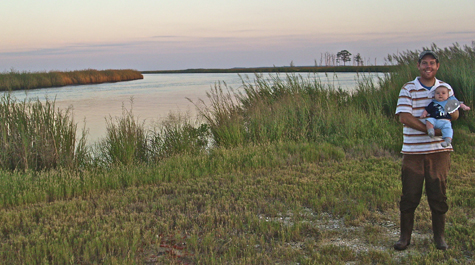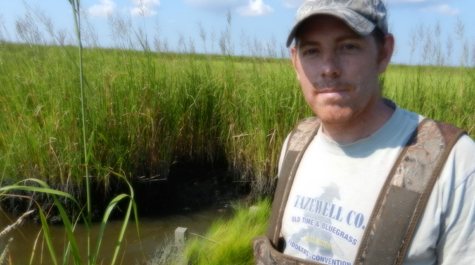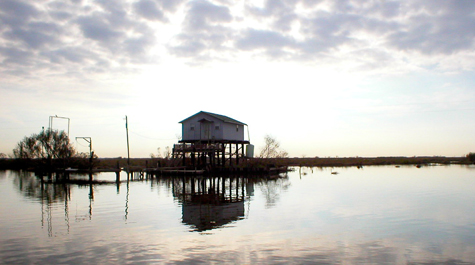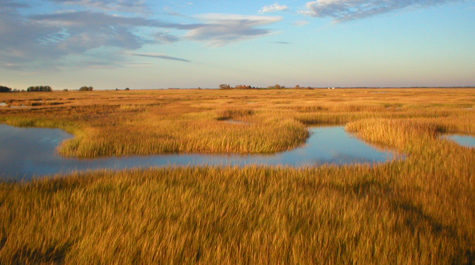Chesapeake Bay marsh expert joins VIMS faculty
Kirwan explores how wetlands respond to climate change
Matt Kirwan gained his interest in coastal wetlands the hard way—through years of muskrat trapping in the marshes of the Eastern Shore.
That long-term interest has now led Kirwan to the Virginia Institute of Marine Science, where he recently joined the faculty as an Assistant Professor. His current research looks at how biological and physical processes interact to govern the response of wetlands to global change.
Kirwan arrived at VIMS in January from the University of Virginia, where he served as a research assistant professor. Prior to his work at UVA, Kirwan completed his doctoral research in 2007 at Duke University. He earned his undergraduate degree from the College of William & Mary in 2002, with a B.S. in geology and a minor in mathematics.
Kirwan says he enjoys studying anything related to salt marshes and how they respond to sea-level rise and other aspects of climate change. “Marshes are important because they protect the coast from storms,” he says. “They also help improve water quality—which makes our seafood business more valuable.”
VIMS Dean and Director John Wells says “Matt is a great example of VIMS’ focus on providing science-based knowledge to help society better manage our interactions with the coastal zone. His studies of how wetlands are responding to climate change will provide key insights for colleagues and policymakers, both in Chesapeake Bay and elsewhere around the world.”
The focus of Kirwan’s current research is to better understand how wetlands respond to rising seas, carbon-dioxide levels, and temperature; how humans influence wetlands even more directly through changes in sediment supply; and how climate-mediated changes in wetland dynamics affect the ability of these ecosystems to store carbon.
Kirwan has worked in marshes all across the United States, including those in Louisiana and Massachusetts, and along both coasts of Canada, but his main focus has always been the Chesapeake region. “Other than Louisiana, we have the biggest marshes in the world,” he says. “You can go a couple of miles and see so many different types.”
Kirwan first became enamored with marshes when his father purchased a piece of Eastern Shore marshland that had been in his extended family for hundreds of years, and even his Indian relatives. “I got to know some of my trapper and waterman cousins a lot better after that,” he says. “One of my relatives had spent most of his life living on the marsh, and he got me started trapping muskrats. I was still in college, so it came at a good time to direct my school and job choices.”
As an undergrad at William & Mary, Kirwan took a course at VIMS where he got to know some of the faculty members. He says that experience greatly influenced his decision to accept his current position. “I was already familiar with VIMS and knew some of the faculty, so that was certainly a plus,” he says.
Another factor in Kirwan’s decision to come to VIMS was the opportunity to live where he does his research. Kirwan admits he isn’t a big fan of travel, and says he’s convinced that in order to really understand the ecosystem you study, you have to live in it. “The abundance of marshes around Gloucester and the Chesapeake region in general played a big role in my decision to join the faculty at VIMS,” he says.
Though his focus is largely on the Chesapeake, Kirwan collaborates with colleagues in countries around the world, including Italy, Belgium, and the Netherlands. “In Virginia, we’re focused on seafood and improving water quality, whereas in Europe they are focused on protecting cities from sea-level rise and storms,” he says. This is why international research is so important—because everyone brings a different scientific perspective.”
Kirwan notes that the size of the marshes along Chesapeake Bay amazes his international colleagues. “They’re astonished at how we actually live beside, own, and use our marshes here,” he says. “Their perspective helps me look at our Chesapeake marshes in a different way, and to understand them better.”
Kirwan’s knowledge of wetland dynamics is already recognized outside VIMS, as evidenced by a recent request to join a panel of experts organized by The Water Institute of the Gulf, which was recently created to address questions concerning Louisiana’s Mid-Barataria Sediment Diversion. This controversial project—which just recently received funding—aims to tap the Mississippi River in order to create 50 square miles of wetlands designed to reinforce the state’s eroding coastline.
As for the future, Kirwan plans to continue studying marshes as they change over the coming decades. “Everyone in the science world is speculating that marshes are valuable sinks of carbon dioxide, so I’d like to tackle that and see if it’s really true,” he says. “I also want to focus on the enormous wetlands currently being created by sea-level rise.”




